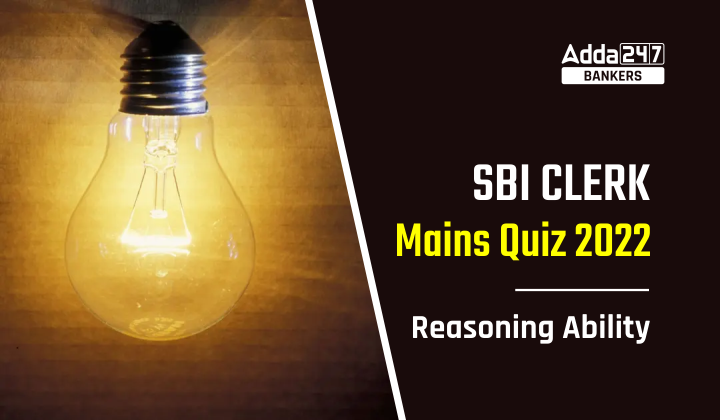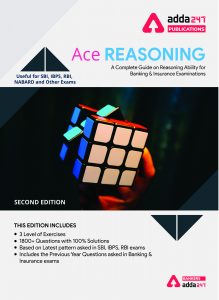Directions (1-5): The question given below consists of two statements numbered I and II given below it. You have to decide whether the data provided in the statements are sufficient to answer the question. Read all the statements and give answer accordingly.
Q1. Six persons J, R, A, B, G and M are having different weights. Who among the following is the heaviest person?
Statements:
I. Only three persons are lighter than G. A is heavier than R and lighter than J. M is heavier than B.
II. B is lighter than M and heavier than G. Four persons are heavier than R. A is not the lightest person.
(a) The data in statement I alone are sufficient to answer the question, while the data in statement II alone are not sufficient to answer the question.
(b) The data in statement II alone are sufficient to answer the question, while the data in statement I alone are not sufficient to answer the question.
(c) The data either in statement I alone or in statement II alone are sufficient to answer the question.
(d) The data given in statements I and II together are not sufficient to answer the question.
(e) The data in statements I and II together are necessary to answer the question.
Q2. Seven persons A, E, H, O, U, Y and Z live in a seven-storeyed building such that the bottommost floor is numbered as 1 and just above it is numbered as 2 and so on. Only one person lives on each floor. Who among the following lives on the topmost floor?
Statements:
I. Two floors are between O and U who lives immediately below Y. Neither O nor Y lives on the topmost floor. Z lives above H who lives on an odd-numbered floor.
II. E lives immediately below Z. Three persons live between H and Y who lives on an even-numbered floor. U does not live on the topmost floor. Only one person lives between O and A who lives immediately above H.
(a) The data in statement I alone are sufficient to answer the question, while the data in statement II alone are not sufficient to answer the question.
(b) The data in statement II alone are sufficient to answer the question, while the data in statement I alone are not sufficient to answer the question.
(c) The data either in statement I alone or in statement II alone are sufficient to answer the question.
(d) The data given in statements I and II together are not sufficient to answer the question.
(e) The data in statements I and II together are necessary to answer the question.
Q3. What is the shortest distance between Q and T?
Statements:
I. U is 20m north of V and 5m east of P. V is 10m east of Y and 15m west of W. R is 10m north of Q which is 15m east of W which is 10m north of X. S is 20m south of T and 7m east of R.
II. X is 8m south of T which is 13m west of U which is 7m south of S. W is 12m east of S and 7m north of V which is 8m west of R. Q is 10m north of Y which is 7m east of P. X is west of Q and P is south of S.
(a) The data in statement I alone are sufficient to answer the question, while the data in statement II alone are not sufficient to answer the question.
(b) The data in statement II alone are sufficient to answer the question, while the data in statement I alone are not sufficient to answer the question.
(c) The data either in statement I alone or in statement II alone are sufficient to answer the question.
(d) The data given in statements I and II together are not sufficient to answer the question.
(e) The data in statements I and II together are necessary to answer the question.
Q4. Six persons N, P, K, R, Z and T are standing on stairs according to their heights such as person on topmost stair is the tallest person and the person on bottommost stairs is the shortest person. What is the height of K?
Statements:
I. K is taller than Z. T is taller than only three persons. N is not shorter than Z.
II. T is taller than both R and Z. N is taller than T but shorter than P.
(a) The data in statement I alone are sufficient to answer the question, while the data in statement II alone are not sufficient to answer the question.
(b) The data in statement II alone are sufficient to answer the question, while the data in statement I alone are not sufficient to answer the question.
(c) The data either in statement I alone or in statement II alone are sufficient to answer the question.
(d) The data given in statements I and II together are not sufficient to answer the question.
(e) The data in statements I and II together are necessary to answer the question.
Q5. Six girls R, N, K, L, D and A have birthdays on dates 5th or 14th in the month of August, September and October but not necessarily in the same order. What is the birthdate of R?
Statements:
I. K is having a birthday after D in the month having an odd number of days. D is not having birthday immediately after or immediately before to A and L. Only two girls are having a birthday between L and N. A is having a birthday on an odd date. The birthday of L is 14th August.
II. Three persons have a birthday between L and N who is having birthday immediately before R. Only one person has birthday between D and R. A does not have birthday on an even number days month.
(a) The data in statement I alone are sufficient to answer the question, while the data in statement II alone are not sufficient to answer the question.
(b) The data in statement II alone are sufficient to answer the question, while the data in statement I alone are not sufficient to answer the question.
(c) The data either in statement I alone or in statement II alone are sufficient to answer the question.
(d) The data given in statements I and II together are not sufficient to answer the question.
(e) The data in statements I and II together are necessary to answer the question.
Directions (6-10): In the following questions, the symbols +, #, %, @ and * are used with the following meaning as illustrated below.
‘P# Q’ means ‘P is neither greater than nor smaller than Q’
‘P+Q’ means ‘P is not smaller than Q’
‘P@Q’ means ‘P is neither smaller than nor equal to Q’
‘P *Q’ means ‘P is not greater than Q’
‘P%Q’ means ‘P is neither greater than nor equal to Q’
Now in each of the following questions assuming the given statements to be true, find which of the three conclusions I, II and III given below them is/are definitely true and give your answer accordingly.
Q6. Statements:
D% F, F@H, H*N
Conclusions:
I. N@F
II. D % N
III. H % D
(a) None is true
(b) Only I is true
(c) Only II is true
(d) Only III is true
(e) Only I and II are true
Q7. Statements:
B+D, D% T, T*M
Conclusions:
I. B@T
II. M@D
III. B@M
(a) Only I is true
(b) Only II is true
(c) Only III is true
(d) Only II and III are true
(e) None of these
Q8. Statements:
K#W, M@W, R+M
Conclusions:
I. K % M
II. W % R
III. R @ K
(a) Only I and II are true
(b) Only I and III are true
(c) Only II and III are true
(d) All I, II and III are true
(e) None of these
Q9. Statements:
A@B, B#C, C+D, D*E
Conclusions:
I. E % B
II. D % A
III. C + A
(a) Only I is true
(b) Only II is true
(c) Only III is true
(d) Only II and III are true
(e) None of these
Q10. Statements:
P@Q, Q%S, S*T, T+O
Conclusions:
I. O @ Q
II. Q % T
III. P @ T
(a) None is true
(b) Only I is true
(c) Only II is true
(d) Only III is true
(e) Only I and II are true
Directions (11-15): In the following questions the symbol *, $, #, % and @ are used with the
following meaning as illustrated below:
‘A $ B’ means ‘A is not smaller than B.’
‘A * B’ means ‘A is neither greater than nor equal to B.’
‘A # B’ means ‘A is neither smaller than nor equal to B.’
‘A % B’ means ‘A is not greater than B.’
‘A @ B’ means ‘A is neither greater than nor smaller than B.’
Now in each of the following questions assuming the statements to be true, find which of the three conclusions I, II and III given below them is/are definitely true and give answer accordingly.
Q11. Statements:
S#J, J$D, D@K, K%Q
Conclusions:
I. Q#D
II. Q@D
III. S#K
(a) Only I and II are true
(b) Only I is true
(c) Only II is true
(d) Only III is true
(e) None of the above
Q12. Statements:
T%P, P$M, M@D, D*Q
Conclusions:
I. D%P
II. Q#P
III. T*M
(a) None is true
(b) Only I is true
(c) Only II is true
(d) Only III is true
(e) Only I and III are true
Q13. Statements:
M@C, C#N, C$R, R*K
Conclusions:
I. K#C
II. R*N
III. M$R
(a) None is true
(b) Only I is true
(c) Only I and III are true
(d) Only III is true
(e) Only I and II are true
Q14. Statements:
T#H, H@M, M*O, O$J
Conclusion:
I. J*M
II. O#H
III. M*T
(a) None is true
(b) Only I is true
(c) Only II is true
(d) Only II and III are true
(e) Only I and II are true
Q15. Statements:
P@S, S%Q, Q*T, T$R
Conclusion:
I. S*T
II. P%T
III. S%R
(a) None is true
(b) Only I is true
(c) Only II is true
(d) Only III is true
(e) Only I and II are true
Solutions






 GA Capsule for SBI Clerk Mains 2025, Dow...
GA Capsule for SBI Clerk Mains 2025, Dow...
 The Hindu Review October 2022: Download ...
The Hindu Review October 2022: Download ...
 Test Prime Subscription by Adda247
Test Prime Subscription by Adda247


